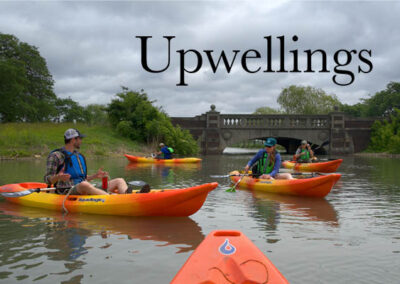A unique project, called SNOWStorm, was started to help learn more about these majestic birds by placing transmitters on the birds.

Recently, seasoned bird banders Chris Neri and Nova Mackentley banded a coastal snowy owl on the shores of Lake Superior. Photo: Chris Neri
The snowy owl (Bubo scandiacus) is a most striking bird. With a stark white body accented by black or brown markings and piercing yellow eyes it makes for a visually stunning bird. Female snowy owls are slightly larger than males and have a wingspan of 4.25 feet to 4.75ft and a weight of 4.5-5 pounds making them the heaviest owl in all of north America, and one of the largest owls in the world.
The snowy owl spends its summers far north in the arctic tundra. They build nests on the ground (one of only a few ground nesting owls) as there are little to no trees at these latitudes. They raise their young on a diet made up almost exclusively of small mammals called lemmings. They are adapted well to diurnal (daytime) hunting as there is almost 24 hours of daylight in the summer of these far northern locations.
Irruption years
Some snowy owls won’t migrate and will spend the winter in the same territory they summer in, while others migrate short to mid-distances finding open fields throughout Canada or the northern United States. In some winters snowy owls will show up in large numbers throughout a large portion of the lower 48 states. These years are known as irruption years, and while it is not entirely clear why irruptions happen, it is thought it may happen when lemming populations are high equating to lots of healthy baby snowy owls.
While many snowy owls eat mostly small mammals and hunt in open fields, a fair number of snowy owls become coastal in the winter months. The owls will set up territories on sandy beaches, rocky seawalls and even ice pack and ice shelves. These birds will subsist on a diet that is made up much more of waterfowl like ducks and grebes. Some snowy owls in coastal areas of Canada have even been documented diving into water and catching fish in similar ways to osprey. Some of the best coastal areas to find snowy owls are in the Great Lakes. Lake St. Clair, Lake Ontario and Lake Michigan are many locations where you can find coastal snowy owls along the beach or edge of the ice.
Project SNOWStorm
The last massive irruption year was in the winter of 2013-2014. Not much was known about snowy owl irruptions or their life cycle in general, and so a unique project was started to help learn more about these majestic birds. The project is called project SNOWStorm, and involves trained experts placing transmitters on the birds. These special locators are solar powered and use cell towers to transmit the exact location of the birds. Even when out of cell range, the transmitters store location information and will transmit once the bird is back in cell range. It appears that 2017-2018 is another sizable irruption year. Recently, seasoned bird banders Chris Neri and Nova Mackentley banded a coastal snowy owl on the shores of Lake Superior. The bird was banded right on the shores of Whitefish Point Michigan and you can track the progress of this bird, nicknamed Gichigami, on the project SNOWStorm website. Hopefully this and other birds banded will help us learn more about these majestic creatures so they can be protected for many years to come.
If you want to see a snowy owl in Michigan in typical open field habitat, there’s no better place then Chippewa county in the eastern Upper Peninsula. Explore the winter birding map at www.northhuronbirding.com to learn about some of their favorite habitats. This map was made by Michigan Sea Grant and MSU Extension and describes how you can find the best winter birding in all of Michigan including snowy owls, pine grosbeaks, snow buntings and many other winter specialties. To find the most recent sightings of snowy owls in your area you can check out eBird, a citizen science project of the Cornell Lab of Ornithology. Anyone can create an account and upload their bird sightings. And anyone can access their data explore tools, like this map of snowy owl sightings.
If you see a snowy…
If you are lucky enough to find a snowy owl, it is very important to enjoy these birds without disturbing them. Keep a safe distance from the bird and don’t do anything to disrupt them. If you are in your car when you find one, stay in it as it will act as a blind. If you are on foot take note of the owl raises its head or body or swivels, it’s head towards you. These are signs the bird is nervous, and you should back away slowly and keep your hands lowered. Learn more about snowy owl etiquette and what you can do to help protect these special creatures.


